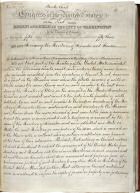 |
1854 Kansas-Nebraska Act
National Archives |
STATEHOOD:In 1803, the United States purchased a large tract of land from France,
the Louisiana Purchase. Most of present-day Kansas came to the United States as part of this
tract. Between 1825 and 1842, fur trappers, merchants, and settlers established the Santa Fe and
Oregon trails, major east-west passages, through the area. By the mid-1800's, Midwesterners were
clamoring to officially open new territories for settlement and railroad construction. A bill to do this
was introduced by Senator Stephen A. Douglas of Illinois.
From the beginning, this bill was embroiled in arguments between pro-slavery citizens and
anti-slavery citizens. The Missouri Compromise of 1820 declared that all land in the Louisiana Purchase
north of 36° 30', except for Missouri, was to be admitted as free land. Based on the Missouri Compromise,
Kansas should have been admitted as free territory. However, for political reasons, Senator Douglas'
bill specified that the citizens of these new territories should decide the issue of slavery for
themselves. Congress finally passed the bill, that contradicted the Missouri Compromise, and on May 30,
1854, Kansas became a territory of the United States.
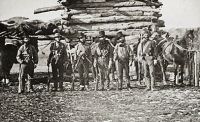 |
Unknown Kansas pioneers - 1856
Kansas State Historical Society
The University of Kansas |
Soon,
settlers from the north and from the south were pouring into Kansas. Unfortunately,
many of the migrations were aided by pro and anti-slavery groups trying to pack the state with
sympathizers. In the 1855 elections, tainted by questionable voting practices, pro-slavery candidates
won control of the legislature. As a result of the pro-slavery legislation that was approved, violence
broke out in Kansas. This violence over the issue of slavery was reported in newspapers throughout the
United States. "Bleeding Kansas" was on everyone's mind.
The pros-slavery group wrote a constitution favoring slavery, but Kansas voters rejected it.
A shift in the legislature occurred and anti-slavery citizens took charge. Pro-slavery laws were repealed
and a constitution forbidding slavery was written. Kansas voters approved this constitution and asked
the United States Congress for statehood. In interesting political turns, it wasn't until after several
Southern states had left the Union that Kansas was admitted to the Union, as the 34th state, on January
29, 1861. |
| |
|
STATE CONSTITUTION:A constitution sets out the rules by which we play the game
of government. Like the rules for any other game, it limits the moves available to players. It describes
how the various players interact with each other, and who has more power in various situations.
Kansas is governed under its original Constitution, created in 1859. Of course, it has
been amended many times. All amendments to the Constitution must by passed through the Legislature and
offered for vote to the citizens of Kansas. To be approved, an amendment must receive 2/3 of the vote in
each house of the Legislature and must receive a majority of votes from Kansas voters. A constitutional
convention may be called with the approval of 2/3 of the legislative vote and a majority vote from Kansas
voters. A statewide election must then be held to approve the actions of the convention.
PREAMBLE:We, the people of Kansas, grateful to Almighty God for our civil and
religious privileges, in order to insure the full enjoyment of our rights as American citizens, do ordain
and establish this constitution of the state of Kansas, with the following boundaries, to wit: Beginning
at a point on the western boundary of the state of Missouri, where the thirty-seventh parallel of north
latitude crosses the same; thence running west on said parallel to the twenty-fifth meridian of longitude
west from Washington; thence north on said meridian to the fortieth parallel of north latitude; thence
east on said parallel to the western boundary of the state of Missouri; thence south with the western
boundary of said state to the place of beginning.
[ KANSAS CONSTITUTION ] |
| |
|
STATE MOTTO:
John James Ingalls
was born in Middleton, Massachusetts on December 29, 1833. He graduated from Williams College in 1855,
studied law, and was admitted to the bar in 1857. Drawn by an advertisement, he left Massachusetts and
headed for Atchison, Kansas. He arrived in 1859. It was in Kansas that he gained his reputation as an
orator, scholar, lawyer, and statesman, known for his keen sarcasm and quick wit.
Ingalls believed in Kansas, and wrote that "the aspiration of Kansas is to reach the unattainable; its dream is the realization of the
impossible." Ingalls chose to live in Kansas because he believed the state had a bright and promising future.
He was 26 years old and already making his mark on Kansas politics when he became a force behind
the creation of the Kansas Constitution that lead to statehood.
Serving as the first Secretary of State for the new state of Kansas, one of the early orders of
business was to design a seal to be used to authenticate official state documents. Ingalls suggested
a simple design that depicted a single star rising from the clouds at the base of a field. A
constellation of 33 stars at the top of the seal was to represent the other states then in the Union.
The rising star symbolized Kansas joining the Union after a stormy struggle. And, of course, a motto
was needed. Considering the hard lives of early Kansas pioneers and the tough battles that Kansas had
gone through and won to become the 34th state, John James Ingalls thought it fitting that Ad Astra per
Aspera, "To the Stars with Difficulty," be added to the seal and adopted as the state motto. Only
some aspects of his design suggestions can be seen in the seal today, but Ad Astra per Aspera
still rings true. |
| |
|
STATE GOVERNMENT:As in the case of the federal government, Kansas's state government is
organized into three branches - legislative, executive, and judicial. The state government is a product of
three documents: the United States Constitution, the Kansas State Constitution, and laws of the state.
The governor of the State of Kansas heads the executive branch, which includes the lieutenant
governor, secretary of state, and attorney general. The governor is elected by a statewide vote for a
four-year term. He, or she, acts as chief administrator responsible for carrying out state laws and
administering the executive budget. The citizens of Kansas elect four other positions in the executive
branch as well. They are the lieutenant governor, the secretary of state, the state treasurer and the
attorney general. The lieutenant governor acts as chief executive when the governor is absent.
The Kansas Legislature consists of a 125-member House of Representatives and a 40-member
Senate.
The Kansas court system consists of state supreme court, a state court of appeals, and 63 county
and municipal courts. The city and county of Denver has special probate and juvenile courts, along
with a separate superior court.
[ GREAT SEAL OF KANSAS ]
[ KANSAS STATE FLAG ] |
| |
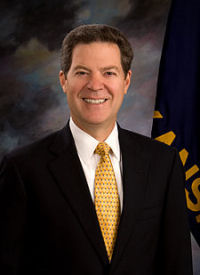 |
Governor Samuel Dale "Sam" Brownback
Courtesy of the State of Kansas |
GOVERNOR:Samuel Dale "Sam" Brownback (Republican)
FIRST LADY:Mary Stauffer Brownback
Throughout his life, Brownback has worked as a radio broadcaster, attorney, teacher, administrator, congressman and senator.
Brownback served in the U.S. Senate from 1996-2010, where he was a member of the Appropriations Committee and the Homeland Security Subcommittee and served as the top-ranking Republican in the Agriculture Appropriations Subcommittee. He also served in the U.S. House of Representatives from 1994-1996, and was the youngest Kansas Secretary of Agriculture.
Sam Brownback was sworn in as governor of Kansas on January 10, 2010.
He and his wife, Mary, have five children.
[ GOVERNOR'S PAGE ]
[ FORMER STATE GOVERNORS ] |
| |
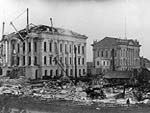 |
| Working on west wing |
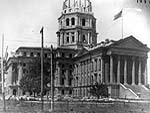 |
| Working on dome |
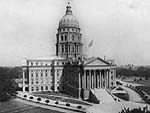 |
| Complete |
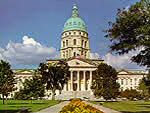 |
Kansas State Capitol Building
All Courtesy Kansas Legislature |
|
KANSAS CAPITOL BUILDING:
Location:Topeka
Date Erected:1866-1903
- It took 37 years to complete the capitol building at a total cost of about $3.2 million.
- The east wing cornerstone was laid October 17, 1866. This wing was completed in 1873.
- The west wing was started in 1879 and enclosed by 1880. It is four feet wider and six feet longer than the east wing.
- Work began on the central portion of the building in 1885. Prior to its construction, the east and west wings were connected by a wooden footbridge called the "Cave of Winds."
- Work on the roof and dome of the central portion began in 1889.
- E. Townsend Mix's building design is described as French Renaissance architecture with Corinthian composite details
- Brown Tennessee marble and varieties of Italian marble decorate the House walls.
- The Statehouse has a cage elevator, one of the few remaining hand-operated elevators. It was installed in 1923.
- The marble in the Senate chamber was imported. The bluish marble at the base came from Belgium, while the onyx in the center portion is from Mexico. The narrow white strip at the top is Italian Carrara marble, but the tan marble carved around the windows and door came from Tennessee.
- In the early days of the Statehouse, a stone fence that was built for protection from cows and other animals was deemed "unsightly" and replaced with a five-board fence around the Capitol Square.
[ ABOUT ]
[ HISTORY ]
[ TOUR ] |
| |
|
STATE REPRESENTATION:The Kansas Legislature is composed of two bodies
like the United States Congress, the House of Representatives and the Senate. The Legislature is referred
to as a bicameral body because it is made up of two houses. The Latin roots of the word bicameral, "bi" and
"cameral," mean two chambers or rooms. The Legislature's most prominent responsibilities are making the
laws in Kansas and for raising and distributing the money necessary to run the state government.
[ LEGISLATIVE BRANCH ] |
| STATE REPRESENTATIVES:Representatives in Kansas each represent people
in a specific area of the state. These areas are called house districts. There are currently 125 men and women
representing 125 house districts in the Kansas House of Representatives. 78 representatives are Republicans
and 47 are Democrats. Each representative serves for a period of two years in the House of Representatives,
after which he or she must run for re-election.
[ STATE REPRESENTATIVES ]
[ LEGISLATIVE DISTRICTS ] (PDF) |
STATE SENATORS:Senators in Kansas each represent people
in a specific area of the state. These areas are called senate districts. There are currently 40 men and
women representing 40 senate districts in the Kansas Senate. 30 representatives are Republicans
and 10 are Democrats. Each senator serves for a period of four years in the Senate, after which he or she
must run for re-election.
[ STATE SENATORS ]
[ LEGISLATIVE DISTRICTS ] (PDF) |
|
| |
|
LEGISLATIVE PROCESS:The legislative branch of government is responsible for making and
maintaining laws within their jurisdiction. United States representatives and senators, federal legislators,
are responsible for laws at the national level and state legislators are responsible for laws at the state
level. A law begins as an idea that is introduced in the Kansas Legislature as a bill by one or more
legislators. The bill then goes through the legislative process to become a law. During this process the bill
may be changed. Not all bills become law.
[ HOW A BILL BECOMES LAW IN KANSAS ]
[ LEGISLATIVE TERMS ] |
| |
| CURRENT LEGISLATION:When the legislature is meeting, it is
said to be "in session." The Kansas Legislature normally meets once a year, in January, for a period of 90 days.
The following link will allow you to look at bills that are currently going through the legislative process.
[ CURRENT LEGISLATION ] |
| |
| STATUTES:The following link will allow you to look at
Kansas's current laws.
[ KANSAS REVISED STATUTES ] |
| |
| COUNTIES:The United States Constitution does not define local government.
Instead, this function is left up to the states.
Counties are a local unit of government within a state. All but two of the states are divided into
counties. Alaska is divided into boroughs and census districts and Louisiana is divided into parishes.
Traditionally, counties performed tasks mandated by the state, such as property assessment, property and vital
statistic record keeping, maintenance of rural roads, administration of local election and judicial functions,
and support of the poor. Today, counties may be responsible for these functions, more or less, but the
responsibilities of county governments vary from state to state.
| COUNTY TRIVIA:
- Kansas is divided into 105 counties
- The largest county in Kansas is Butler County. It covers 1,428 square miles.
- The smallest county, with an area of only 151 square miles, is the Unified Government of Wyandotte County/K.C.
- The most populated county is Sedgwick County. 452,869 people live in Sedgwick County. (2000 census)
- Only 1,534 people live in Greeley County. (2000 census)
[ ABOUT COUNTY GOVERNMENT ]
[ COUNTY GOVERNMENT ]
[ KANSAS ASSOCIATION OF COUNTIES ]
[ ASSOCIATION OF U.S. COUNTIES ]
[ US CENSUS BUREAU ]
[ STATE MAPS ] |
|
| |
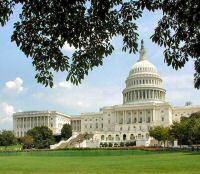 |
United States Capitol Building
Washington, DC |
U.S. CONGRESSIONAL DELEGATION:
The legislative branch of the United States government makes laws for our nation and raises and distributes
money to run the United States government. The most evident part of the legislative branch is the United
States Congress. Congress is divided into two parts, called houses. The two parts are the Senate and the House
of Representatives. Congress is referred to as a bicameral body because it is made up of two houses. The Latin
roots of the word bicameral, "bi" and "cameral," mean two chambers or rooms. Members of the Senate are called
Senators and members of the House of Representatives are called Representatives. Senators and representatives
serving in these two bodies are sometimes referred to as congressmen, or women, and sometimes as legislators
because their business is to legislate or make laws. The role of the legislative branch is defined in the
United States Constitution.
[ THE UNITED STATES CONSTITUTION ]
Each state elects people to represent them in the United States Congress in Washington, DC. The citizens of each
state elect two senators to represent them in the Senate. They also elect representatives to represent them in
the House of Representatives. The number of representatives each state sends to the House of Representatives
is not a specific number like the Senate, but is based on the population of the state. The people, that are
elected to represent the state's citizens in the United States Congress, are referred to as the congressional
delegation.
There are 100 senators in the U.S. Senate. Each is elected to a term, in the Senate, of six years. There are 435
representatives in the U.S. House of Representatives. Each is elected to a term, in the "House," of two
years.
The citizens of Kansas elect two people, like every other state, to represent them in the Senate and
four people, based on Kansas's population, to represent them in the House of Representatives.
|
| |
|
broken links to us. We really appreciate it. |
Source:. "Kansas Governor Sam Brownback." National Governors Association. National Governors Association, 2011. Web. 1 Apr 2012.
Source: State of Kansas Web Site, (http://www.accesskansas.org), April 16, 2004
Source: Office of the Governor of Kansas, (http://www.ksgovernor.org/), April 16, 2004
Source: Kansas Legislature, (http://www.kslegislature.org/), April 16, 2004
Source: Kansas State Historical Society, (http://www.kshs.org/), April 16, 2004
Source: National Governor's Association, (http://nga.org), April 16, 2004 |

 |
|
|
[ HOME
|| INTRO
|| SYMBOLS
|| ALMANAC
|| ECONOMY
|| GEOGRAPHY
|| STATE MAPS
|| PEOPLE
|| GOVERNMENT
]
[ FORUM
|| NEWS
|| COOL SCHOOLS
|| STATE QUIZ
|| BOOK STORE
|| MARKETPLACE
|| STATE LINKS
]
|| GUESTBOOK
|| CONTACT US
|| PRIVACY STATEMENT
] |
Site designed exclusively for NETSTATE.COM by NSTATE

NETSTATE.COM is a Trademark of NSTATE, LLC.
Copyright © 2003- by NSTATE, LLC. All rights reserved.
No copyright is claimed on non-original or licensed material.
Support NETSTATE
Top |
|



